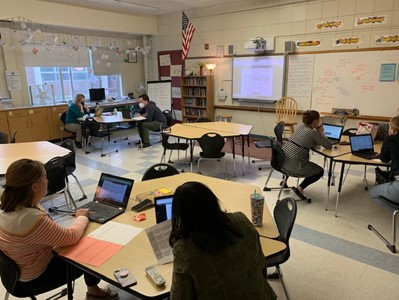Get support for student success - right in your inbox
NHLI | New Hampshire Learning Initiative
All Students Deserve a Quality Education
/ April 19, 2022
Realizing Student-Focused Change Through Distributed Leadership
“Change is hard because people overestimate the value of what they have—and underestimate the value of what they may gain by giving that up.” — James Belasco and Ralph Stayer – Flight of the Buffalo (1994)

Despite intrinsically understanding that our world is rapidly evolving and therefore, how we prepare students in our schools to effectively navigate this world must also evolve, actually DOING THIS in schools presents some significant challenges and mindset shifts.
We recognize that the typical, historical model of building administrators unilaterally making all decisions within a school is not going to initiate the change processes we need to make the right change in our schools deep and lasting. True change must be realized and sustained through a shared leadership model; comprised of administrators AND teachers, who engage in this work together. This lens is supported through significant research over the past two-plus decades.
Richard Elmore (2000), a former professor of educational leadership at Harvard University, recognized that “In… teaching and learning, there is no way to perform the complex tasks involved without distributing the responsibility for leadership and creating a common culture that makes this distributed leadership coherent.” (p. 5) John Kotter, Harvard University faculty and widely respected expert in leadership and change noted in 2012 that “because major change is so difficult to accomplish, a powerful force is required to sustain the process.” (p. 53) More recently, Wilhoit, Pittenger, and Rickbaugh in Leading In Learning (2015) state that “Leadership is not the sole responsibility of a single individual. Leadership is the work of a team that possesses complementary knowledge, skills, dispositions, and contextual knowledge.” (p. 9). In fact, as DuFour, DuFour, Eaker, Many, and Mattos (2016) note “no one person will have the energy, expertise, and influence to lead a complex change process” (p. 27).
We have found in our work with schools that the “powerful force” needed to make the desired changes in our schools a reality is a guiding coalition, or building leadership team, whose charge is to embrace a shared leadership model in which administrators and teachers engage in understanding, planning, and ultimately instituting lasting change together.
The development of the guiding coalition is very important. As a former building principal, it is one of the very first actions I took when beginning that role. I recognized that what we wanted to do could not be envisioned or led by one or two people. It had to be collaboratively developed, introduced, practiced, and ultimately sustained. This blog article, from 2013, outlines some of our learning from that time, learning that has been instrumental in helping me better understand the importance of shared leadership.
In my work in schools and districts now, I am explicitly working to align the various levels of a school system’s mindsets and actions to adequately develop a collaborative approach to problem solving focused on how to best meet the unique needs of each learner within their building(s). This includes work focused at the district level, where it is critically important to clarify the why, as well as the non-negotiables related to what’s tight and what’s loose. These collective conversations and subsequent decisions help to, as Dr. Bill Harbron, Superintendent of Schools of the Dover School District notes, “develop a common focus, understanding, and commitment to the district’s and/or school’s direction and goals.” Additionally, by disbursing leadership responsibilities, districts and schools are developing, as Dr. Harbron states, “the capacity of the district and the school to be a learning organization that can adapt to every changing environment of education.” The support focused at the building level is multi-faceted, as it must align to the district tight while also supporting teachers in the classroom. And finally, our support at the team level is focused on the day-to-day in the classroom, and the various activities teams undertake to ensure learning for all.
It is critical that the decisions schools make are grounded in the why, and that time is carved out for the important conversations among staff to occur to share ideas, problem solve, and tackle next steps together. This allows for a better understanding (and a trust) in both why and how decisions are made. Thomas Sergiovanni (2007) stated that “When people are gathered together to share ideas and to commit to these ideas, their relationships change. They make promises to each other—implicitly perhaps, but promises nonetheless. And thus they are likely to feel morally obliged to keep their promises (p. 3).” This collective commitment to the decisions that are made is key. It is owned by everyone and therefore will have much greater potential to be carried forward. As Carolyn O’Connor, teacher at Rundlett Middle School in the Concord School District stated, what we are doing is “more than the superficial delegation of responsibility. Rather, it serves to promote diversity in perspective, representation, and voice, allowing for authentic and impactful team agency.”
It can be frustrating for the change process to unfold. It doesn’t happen quickly. In fact, for change to truly take root, a staff must try together, fail together, learn together, and ultimately own outcomes together. These experiences are what allows the collective to own the process, to want to make things better (for students and for themselves), and to invest in decisions and most importantly, in each other. Paulette Fitzgerald, principal of Rundlett Middle School in Concord, NH has allowed this process to occur with targeted, specific learning opportunities for administrators and teacher leaders to experience together, all with a clear mission of implementing competency-based practices throughout their school. Principal Fitzgerald recently reflected that “being a leader isn’t about power or control, it’s about building the capacity of those around us-our teachers… a truly powerful thing that is the only way to make meaningful lasting change.”
Ultimately, I believe we in education all want the same things. We want to be able to be a part of something bigger than ourselves, something that truly supports students in learning, and setting them on their own path to success. To do that most successfully, we need to ensure that our mindsets, practices, and the structures within our schools support collaboration, interdependence, shared decision making and responsibility.
About the Author
Jonathan directs innovative, competency-based projects for the New Hampshire Learning Initiative and is co-author of the newly released Unpacking the Competency-Based Classroom: Equitable, Personalized Learning in a PLC at Work (Solution Tree, 2022) written with Brian Stack, and Breaking With Tradition: The Shift to Competency Based Learning in PLCs at Work (Solution Tree, 2018), also written with Brian Stack. Formerly, Jonathan was a principal in an elementary school recognized nationally as a model Professional Learning Community and competency-based school. Jonathan has consulted, coached, and presented at conferences and Institutes throughout the United States and lives with his wife and three children on the New Hampshire Seacoast.
Categories: NHLInsights, Research and Resources
